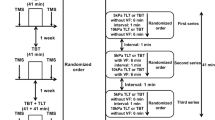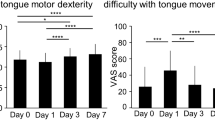Abstract
Given the evidence that the primary motor cortex (MI) consists of subpopulations of upper motor neurons tuned to different directional parameters of a motor movement, this study hypothesized that novel motor skill training involving either a bidirectional or more complex multidirectional tongue-typing movement should produce distinct training-related features of tongue MI neuroplasticity in humans. Novel motor skill training consisted of tongue typing using custom-made intra-oral keypads for 30-min over two consecutive days. The bidirectional keypad consisted of three sensors positioned along the upper palatal midline as a 3 × 1 array, whereas the multidirectional keypad consisted of nine sensors arranged as a 3 × 3 array that was centred along the upper palatal midline. Each sensor corresponded to one letter and participants were asked to type sequences of letters by accurately placing the tongue over the correct sensor. Before and after each training session, excitability of the tongue MI was assessed with transcranial magnetic stimulation (TMS)—motor evoked potentials (MEPs) over 13 motor map sites and TMS–MEP stimulus–response curves were constructed for the first dorsal interosseous (FDI, as an internal control). Tongue-typing performance improved within and across training days for both groups; although bidirectional training displayed greater success. Bidirectional and multidirectional training were associated with increases and decreases in a number of cortical motor map sites from where tongue activity could be evoked, however; multidirectional training was associated with a greater number of cortical motor map sites with increased excitability and a shift in the centre of gravity of the motor map. No effects of training were found on the FDI TMS–MEP stimulus–response curves. This study revealed distinct training-related features of tongue MI neuroplasticity and proposes that a greater amount of functionally related neuronal populations may be ‘trained’ by the inclusion of different and more complex directional parameters within a novel motor task.









Similar content being viewed by others
References
Adkins DL, Boychuk J, Remple MS, Kleim JA (2006) Motor training induces experience-specific patterns of plasticity across motor cortex and spinal cord. J Appl Physiol 101:1776–1782
Amirikian B, Georgopoulos AP (2000) Directional tuning profiles of motor cortical cells. Neurosci Res 36:73–79
Andreasen Struijk LN (2006) An inductive tongue computer interface for control of computers and assistive devices. IEEE Trans Biomed Eng 53:2594–2597
Arce FI, Ross CF, Lee JC, Sessle B, Hatsopoulos NG (2011) Decoding tongue movements using orofacial motor cortical ensembles in behaving macaques. SfN, Washington
Arce FI, Hatsopoulos N, Takahashi K, Pesce L, Sessle B, Ross C (2012) Directional information in the primate orofacial sensorimotor cortex. SFN Oct 13–17
Arima T, Yanagi Y, Niddam DM, Ohata N, Arendt-Nielsen L, Minagi S, Sessle BJ, Svensson P (2011) Corticomotor plasticity induced by tongue-task training in humans: a longitudinal fMRI study. Exp Brain Res 212:199–212
Armstrong DM, Drew T (1985) Electromyographic responses evoked in muscles of the forelimb by intracortical stimulation in the cat. J Physiol 367:309–326
Asanuma H, Rosen I (1972) Topographical organization of cortical efferent zones projecting to distal forelimb muscles in the monkey. Exp Brain Res 14:243–256
Ashe J, Georgopoulos AP (1994) Movement parameters and neural activity in motor cortex and area 5. Cereb Cortex 4:590–600
Avivi-Arber L, Martin R, Lee JC, Sessle BJ (2011) Face sensorimotor cortex and its neuroplasticity related to orofacial sensorimotor functions. Arch Oral Biol 56:1440–1465
Bastian AJ (2008) Understanding sensorimotor adaptation and learning for rehabilitation. Curr Opin Neurol 21:628–633
Belda-Lois JM, Mena-del Horno S, Bermejo-Bosch I, Moreno JC, Pons JL, Farina D, Iosa M, Molinari M, Tamburella F, Ramos A, Caria A, Solis-Escalante T, Brunner C, Rea M (2011) Rehabilitation of gait after stroke: a review towards a top–down approach. J Neuroeng Rehabil 8:66
Berg RW, Kleinfeld D (2003) Vibrissa movement elicited by rhythmic electrical microstimulation to motor cortex in the aroused rat mimics exploratory whisking. J Neurophysiol 90:2950–2963
Boudreau S, Romaniello A, Wang K, Svensson P, Sessle BJ, Arendt-Nielsen L (2007) The effects of intra-oral pain on motor cortex neuroplasticity associated with short-term novel tongue-protrusion training in humans. Pain 132:169–178
Boudreau SA, Farina D, Falla D (2010a) The role of motor learning and neuroplasticity in designing rehabilitation approaches for musculoskeletal pain disorders. Man Ther 15:410–414
Boudreau SA, Hennings K, Svensson P, Sessle BJ, Arendt-Nielsen L (2010b) The effects of training time, sensory loss and pain on human motor learning. J Oral Rehabil 37:704–718
Caltenco H, Lontis ER, Bentsen B, Struijk LN (2012) Effects of sensory feedback in intra-oral target selection tasks with the tongue. Disabil Rehabil Assist Technol. Early Online: 1–10
Corneal SF, Butler AJ, Wolf SL (2005) Intra- and intersubject reliability of abductor pollicis brevis muscle motor map characteristics with transcranial magnetic stimulation. Arch of Phys Med and Rehabil 86:1670–1675
Georgopoulos AP, Kalaska JF, Caminiti R, Massey JT (1982) On the relations between the direction of two-dimensional arm movements and cell discharge in primate motor cortex. J Neurosci 2:1527–1537
Gryga M, Taubert M, Dukart J, Vollmann H, Conde V, Sehm B, Villringer A, Ragert P (2012) Bidirectional gray matter changes after complex motor skill learning. Front Syst Neurosci 6:37
Huang CS, Sirisko MA, Hiraba H, Murray GM, Sessle BJ (1988) Organization of the primate face motor cortex as revealed by intracortical microstimulation and electrophysiological identification of afferent inputs and corticobulbar projections. J Neurophysiol 59:796–818
Huang CS, Hiraba H, Murray GM, Sessle BJ (1989) Topographical distribution and functional properties of cortically induced rhythmical jaw movements in the monkey (Macaca fascicularis). J Neurophysiol 61:635–650
Karni A, Meyer G, Jezzard P, Adams MM, Turner R, Ungerleider LG (1995) Functional MRI evidence for adult motor cortex plasticity during motor skill learning. Nature 377:155–158
Kothari M, Svensson P, Huo X, Ghovanloo M, Baad-Hansen L (2012) Force and complexity of tongue task training influences behavioral measures of motor learning. Eur J Oral Sci 120:46–53
Krings T, Topper R, Foltys H, Erberich S, Sparing R, Willmes K, Thron A (2000) Cortical activation patterns during complex motor tasks in piano players and control subjects. A functional magnetic resonance imaging study. Neurosci Lett 278:189–193
Lontis ER, Andreasen Struijk LN (2010) Design of inductive sensors for tongue control system for computers and assistive devices. Disabil Rehabil Assist Technol 5:266–271
Martin RE, Kemppainen P, Masuda Y, Yao D, Murray GM, Sessle BJ (1999) Features of cortically evoked swallowing in the awake primate (Macaca fascicularis). J Neurophysiol 82:1529–1541
McGuinness E, Sivertsen D, Allman JM (1980) Organization of the face representation in macaque motor cortex. J Comp Neurol 193:591–608
Milton J, Solodkin A, Hlustik P, Small SL (2007) The mind of expert motor performance is cool and focused. Neuroimage 35:804–813
Molier BI, Van Asseldonk EH, Hermens HJ, Jannink MJ (2010) Nature, timing, frequency and type of augmented feedback; does it influence motor relearning of the hemiparetic arm after stroke? A systematic review. Disabil Rehabil 32:1799–1809
Muellbacher W, Ziemann U, Boroojerdi B, Cohen L, Hallett M (2001) Role of the human motor cortex in rapid motor learning. Exp Brain Res 136:431–438
Murray GM, Sessle BJ (1992a) Functional properties of single neurons in the face primary motor cortex of the primate. I. Input and output features of tongue motor cortex. J Neurophysiol 67:747–758
Murray GM, Sessle BJ (1992b) Functional properties of single neurons in the face primary motor cortex of the primate. III. Relations with different directions of trained tongue protrusion. J Neurophysiol 67:775–785
Naselaris T, Merchant H, Amirikian B, Georgopoulos AP (2006) Large-scale organization of preferred directions in the motor cortex. II. Analysis of local distributions. J Neurophysiol 96:3237–3247
Pappas CL, Strick PL (1981a) Anatomical demonstration of multiple representation in the forelimb region of the cat motor cortex. J Comp Neurol 200:491–500
Pappas CL, Strick PL (1981b) Physiological demonstration of multiple representation in the forelimb region of the cat motor cortex. J Comp Neurol 200:481–490
Pascual-Leone A, Nguyet D, Cohen LG, Brasil-Neto JP, Cammarota A, Hallett M (1995) Modulation of muscle responses evoked by transcranial magnetic stimulation during the acquisition of new fine motor skills. J Neurophysiol 74:1037–1045
Paz R, Vaadia E (2004) Learning-induced improvement in encoding and decoding of specific movement directions by neurons in the primary motor cortex. PLoS Biol 2:E45
Ridding MC, Rothwell JC (1997) Stimulus/response curves as a method of measuring motor cortical excitability in man. Electroencephalogr Clin Neurophysiol 105:340–344
Rossi S, Hallett M, Rossini PM, Pascual-Leone A, Safety of TMS Consensus Group (2009) Safety, ethical considerations, and application guidelines for the use of transcranial magnetic stimulation in clinical practice and research. Clin Neurophysiol 120:2008–2039
Rossi S, Hallett M, Rossini PM, Pascual-Leone A (2011) Screening questionnaire before TMS: an update. Clin Neurophysiol 122:1686
Sadato N, Campbell G, Ibanez V, Deiber M, Hallett M (1996) Complexity affects regional cerebral blood flow change during sequential finger movements. J Neurosci 16:2691–2700
Sessle BJ, Wiesendanger M (1982) Structural and functional definition of the motor cortex in the monkey (Macaca fascicularis). J Physiol 323:245–265
Smyth C, Summers JJ, Garry MI (2010) Differences in motor learning success are associated with differences in M1 excitability. Hum Mov Sci 29:618–630
Stark E, Drori R, Asher I, Ben-Shaul Y, Abeles M (2007) Distinct movement parameters are represented by different neurons in the motor cortex. Eur J Neurosci 26:1055–1066
Stark E, Drori R, Abeles M (2009) Motor cortical activity related to movement kinematics exhibits local spatial organization. Cortex 45:418–431
Suzuki M, Kirimoto H, Onishi H, Yamada S, Tamaki H, Maruyama A, Yamamoto J (2012) Reciprocal changes in input-output curves of motor evoked potentials while learning motor skills. Brain Res 1473:114–123
Svensson P, Romaniello A, Arendt-Nielsen L, Sessle BJ (2003) Plasticity in corticomotor control of the human tongue musculature induced by tongue-task training. Exp Brain Res 152:42–51
Svensson P, Romaniello A, Wang K, Arendt-Nielsen L, Sessle BJ (2006) One hour of tongue-task training is associated with plasticity in corticomotor control of the human tongue musculature. Exp Brain Res 173:165–173
Taylor DM, Tillery SI, Schwartz AB (2002) Direct cortical control of 3D neuroprosthetic devices. Science 296:1829–1832
Tyc F, Boyadjian A (2011) Plasticity of motor cortex induced by coordination and training. Clin Neurophysiol 122:153–162
Wang L, Conner JM, Rickert J, Tuszynski MH (2011) Structural plasticity within highly specific neuronal populations identifies a unique parcellation of motor learning in the adult brain. Proc Natl Acad Sci US 108:2545–2550
Acknowledgments
This work was supported by Danish Research Council [645-03-0185]; Canadian Institutes of Health Research [STP 53877 Cellsignals and MOP 4918]; Danish Technical Research council; Det Obelske Familefond.
Author information
Authors and Affiliations
Corresponding author
Rights and permissions
About this article
Cite this article
Boudreau, S.A., Lontis, E.R., Caltenco, H. et al. Features of cortical neuroplasticity associated with multidirectional novel motor skill training: a TMS mapping study. Exp Brain Res 225, 513–526 (2013). https://doi.org/10.1007/s00221-012-3391-2
Received:
Accepted:
Published:
Issue Date:
DOI: https://doi.org/10.1007/s00221-012-3391-2




